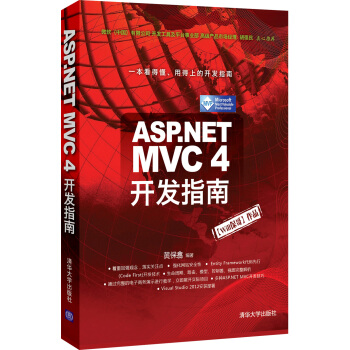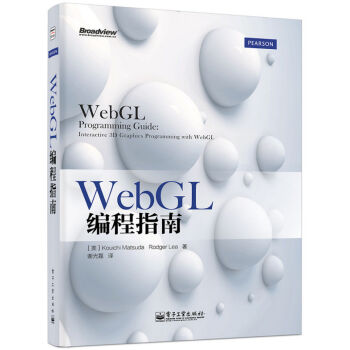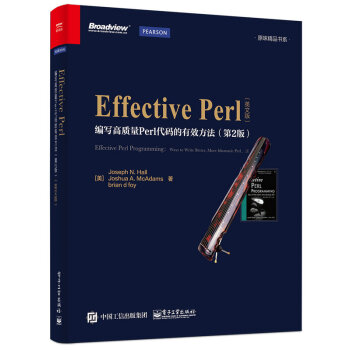
Effective Perl:编写高质量Perl代码的有效方法(第2版 英文版) pdf epub mobi txt 电子书 下载 2026
- Perl
- Programming
- Effective Perl
- Code Quality
- Best Practices
- Software Development
- 2nd Edition
- English
- Programming Language
- Computer Science

具体描述
产品特色
内容简介
《EffectivePerl:编写高质量Perl代码的有效方法(第2版)(英文版)》是Perl编程领域的“圣经”级著作。它提供了100多个翔实的应用案例,足以涵盖编程过程中经常遇到的方方面面,由此详细阐释出各种高效且简洁的写法。《EffectivePerl:编写高质量Perl代码的有效方法(第2版)(英文版)》第1版曾畅销十年之久,而在第2版中不仅修正了前版存在的一些问题,更与时俱进地引入了许多Perl领域的新主题,使内容更加完善丰富,也更具实用性。
《EffectivePerl:编写高质量Perl代码的有效方法(第2版)(英文版)》为初级Perl程序员铺就了一条通往高阶之路,而对高级Perl程序员而言,也是必备的技术参考书。
作者简介
Joseph N. Hall,自称“电脑神童”,一路玩着得州仪器的可编程计算器和配有 4KB 内存的 Radio Shack TRS-80 Model 1 长大。14 岁时初次教授计算机课程。Joseph 拥有北卡罗来纳州立大学计算机科学学士学位,自 1984 年起开始以编程为生。他从 1987 年起开始使用 UNIX 和 C,自 1993 年以来一直在使用 Perl。他的兴趣涉及软件工具和编程语言、钢琴和电子琴,以及高尔夫。
Joshua A. McAdams 活跃于 Perl 社区已近 5 年。他创办了Perlcast,主持过两届在芝加哥的YAPC::NA,他为 Chicago.pm 举办会议,在世界各地的 Perl 会议上做过发言,是一位 CPAN 作者。这是他的图书处女作,不过此前已为 The Perl Review 和 Perl Advent Calendar 写过文章。至于日常工作,Josh 就职于 Google,在那里他的日常开发并不一定涉及 Perl,不过只要可能他就会 使用。
Brian D Foy 是《Perl 语言入门(第5版)》和 Intermediate Perl 的合著者,以及《精通 Perl》的作者。他发起了一个 Perl 用户组 New York Perl Mongers,出版了 The Perl Review,维护着部分 Perl 核心文档,是一名 Perl 讲师,并常在大会上发言。
目录
推荐序
前言
致谢
关于作者
Introduction
Chapter 1 The Basics of Perl
Item 1. Find the documentation for Perl and its modules.
Item 2. Enable new Perl features when you need them.
Item 3. Enable strictures to promote better coding.
Item 4. Understand what sigils are telling you.
Item 5. Know your variable namespaces.
Item 6. Know the difference between string and numeric comparisons.
Item 7. Know which values are false and test them accordingly.
Item 8. Understand conversions between strings and numbers.
Item 9. Know the difference between lists and arrays.
Item 10. Don’t assign undef when you want an empty array.
Item 11. Avoid a slice when you want an element.
Item 12. Understand context and how it affects operations.
Item 13. Use arrays or hashes to group data.
Item 14. Handle big numbers with bignum .
Chapter 2 Idiomatic Perl
Item 15. Use $_ for elegance and brevity.
Item 16. Know Perl’s other default arguments.
Item 17. Know common shorthand and syntax quirks.
Item 18. Avoid excessive punctuation.
Item 19. Format lists for easy maintenance.
Item 20. Use foreach , map , and grep as appropriate.
Item 21. Know the different ways to quote strings.
Item 22. Learn the myriad ways of sorting.
Item 23. Make work easier with smart matching.
Item 24. Use given-when to make a switch statement.
Item 25. Use do {} to create inline subroutines.
Item 26. Use List::Util and List::MoreUtils for easy list manipulation.
Item 27. Use autodie to simplify error handling.
Chapter 3 Regular Expressions
Item 28. Know the precedence of regular expression operators.
Item 29. Use regular expression captures.
Item 30. Use more precise whitespace character classes.
Item 31. Use named captures to label matches.
Item 32. Use noncapturing parentheses when you need only grouping.
Item 33. Watch out for the match variables.
Item 34. Avoid greed when parsimony is best.
Item 35. Use zero-width assertions to match positions in a string.
Item 36. Avoid using regular expressions for simple string operations.
Item 37. Make regular expressions readable.
Item 38. Avoid unnecessary backtracking.
Item 39. Compile regexes only once.
Item 40. Pre-compile regular expressions.
Item 41. Benchmark your regular expressions.
Item 42. Don’t reinvent the regex.
Chapter 4 Subroutines
Item 43. Understand the difference between my and local .
Item 44. Avoid using @_ directly unless you have to.
Item 45. Use wantarray to write subroutines returning lists.
Item 46. Pass references instead of copies.
Item 47. Use hashes to pass named parameters.
Item 48. Use prototypes to get special argument parsing.
Item 49. Create closures to lock in data.
Item 50. Create new subroutines with subroutines.
Chapter 5 Files and Filehandles
Item 51. Don’t ignore the file test operators.
Item 52. Always use the three-argument open .
Item 53. Consider different ways of reading from a stream.
Item 54. Open filehandles to and from strings.
Item 55. Make flexible output.
Item 56. Use File::Spec or Path::Class to work with paths.
Item 57. Leave most of the data on disk to save memory.
Chapter 6 References
Item 58. Understand references and reference syntax.
Item 59. Compare reference types to prototypes.
Item 60. Create arrays of arrays with references.
Item 61. Don’t confuse anonymous arrays with list literals.
Item 62. Build C-style structs with anonymous hashes.
Item 63. Be careful with circular data structures.
Item 64. Use map and grep to manipulate complex data structures.
Chapter 7 CPAN
Item 65. Install CPAN modules without admin privileges.
Item 66. Carry a CPAN with you.
Item 67. Mitigate the risk of public code.
Item 68. Research modules before you install them.
Item 69. Ensure that Perl can find your modules.
Item 70. Contribute to CPAN.
Item 71. Know the commonly used modules.
Chapter 8 Unicode
Item 72. Use Unicode in your source code.
Item 73. Tell Perl which encoding to use.
Item 74. Specify Unicode characters by code point or name.
Item 75. Convert octet strings to character strings.
Item 76. Match Unicode characters and properties.
Item 77. Work with graphemes instead of characters.
Item 78. Be careful with Unicode in your databases.
Chapter 9 Distributions
Item 79. Use Module::Build as your distribution builder.
Item 80. Don’t start distributions by hand.
Item 81. Choose a good module name.
Item 82. Embed your documentation with Pod.
Item 83. Limit your distributions to the right platforms.
Item 84. Check your Pod.
Item 85. Inline code for other languages.
Item 86. Use XS for low-level interfaces and speed.
Chapter 10 Testing
Item 87. Use prove for flexible test runs.
Item 88. Run tests only when they make sense.
Item 89. Use dependency injection to avoid special test logic.
Item 90. Don’t require more than you need to use in your methods.
Item 91. Write programs as modulinos for easy testing.
Item 92. Mock objects and interfaces to focus tests.
Item 93. Use SQLite to create test databases.
Item 94. Use Test::Class for more structured testing.
Item 95. Start testing at the beginning of your project.
Item 96. Measure your test coverage.
Item 97. Use CPAN Testers as your QA team.
Item 98. Set up a continuous build system.
Chapter 11 Warnings
Item 99. Enable warnings to let Perl spot suspicious code.
Item 100. Use lexical warnings to selectively turn on or off complaints.
Item 101. Use die to generate exceptions.
Item 102. Use Carp to get stack traces.
Item 103. Handle exceptions properly.
Item 104. Track dangerous data with taint checking.
Item 105. Start with taint warnings for legacy code.
Chapter 12 Databases
Item 106. Prepare your SQL statements to reuse work and save time.
Item 107. Use SQL placeholders for automatic value quoting.
Item 108. Bind return columns for faster access to data.
Item 109. Reuse database connections.
Chapter 13 Miscellany
Item 110. Compile and install your own perl s.
Item 111. Use Perl::Tidy to beautify code.
Item 112. Use Perl Critic.
Item 113. Use Log::Log4perl to record your program’s state.
Item 114. Know when arrays are modified in a loop.
Item 115. Don’t use regular expressions for comma-separated values.
Item 116. Use unpack to process columnar data.
Item 117. Use pack and unpack for data munging.
Item 118. Access the symbol table with typeglobs.
Item 119. Initialize with BEGIN ; finish with END .
Item 120. Use Perl one-liners to create mini programs.
Appendix A Perl Resources
Appendix B Map from First to Second Edition
Books
Websites
Blogs and Podcasts
Getting Help
Index
前言/序言
再版前言很多Perl程序员都是通过本书的第1版启蒙的。在1998年Addison-Wesley出版第1版的时候,整个世界似乎都在使用Perl。当时.com大潮正在兴起,所有懂点HTML的人都能找到程序员的工作。而这些人一旦开始编程,就需要迅速提升自己的技能。本书和其他两本“圣经级”著作Programming Perl1、Learning Perl2基本上是这些新程序员的必读书。
当时市面上还有不少其他的Perl书籍。如今的编程学习者应该很难想象当时美国书店的情况,那时候的书店中有数十米的书架摆放的都是编程书,而大多数都是关于Java和Perl的。如今的书店则只在一个小角落里摆放编程书,每种语言往往只会有几本书,而且大多数的书在上架后的半年内就会被其他书取代。
尽管如此,本书还是畅销了十年之久。这要归功于Joseph Hall对Perl编程哲学的深刻理解和他本人的过人智慧。毕竟这本书主要讨论的是Perl编程思想,他在第1版中给出的建议直到现在都还非常实用。
不过,如今Perl的世界和1998年相比已经有了很大的变化,值得提倡的理念也更多了。CPAN(Comprehensive Perl Archive Network,Perl综合典藏网)仅仅经过几年的发展,如今已经成了Perl最吸引人的特性。人们已经发现了许多更新更好的编程方式,而且这十年来业界积累了更多使用Perl的经验,也催生了很多新的最佳实践和惯用技巧。
自从本书第1版面世以来,Perl本身也有了很大的变化。第1版存在于从Perl 4到Perl 5的过渡时期,当时大家仍然在广泛使用Perl 4的一些古老特性。在这个新版本中,我们基本上消除了这些差异。现在只有一个Perl,那就是Perl 5(本书不讨论Perl 6,因为它值得另写一本书)。
现代Perl已经能够支持Unicode(而不仅仅是ASCII),因此你也应该适应这一点,我们为这个主题专门设置了一章。几年来,在Michael Schwern的推动之下,Perl已经成为被测试最多的语言,几乎每一个模块都非常稳定。Perl粉丝们怀念的“蛮荒时代”已经成为历史。今天,即使是快速原型的开发也可以同时考虑测试。如果你开发的是企业应用,那么你应该好好看一看我们针对测试给出的建议。如果你是一位正则表达式高手,那么你一定想了
解最新的Perl 正则特性,本书将介绍其中那些最常用的。
Perl 仍然在成长中,新的主题还在不断涌现。有些主题本身就值得用一本书的篇幅来介绍,比如Moose 这个“后现代”的Perl 面向对象框架,因而本书也就不勉为其难地去涵盖它们了。另一些主题,比如POE(Perl Object Environment,Perl 对象环境)、对象关系映射器,还有GUI 工具包等也都因为同样的原因而没有办法在本书中详细介绍。不过,我们已经计划再写一本More Effective Perl,到时候可能会涵盖更多的内容。
最后,Perl 的各种文档和专著较以前也丰富多了。虽然本书会尽可能多地讲到我们认为你应该知道的内容,但如果市面上已经有了详细讨论某些内容的书,我们自然也就不必置喙了,附录会推荐其他一些Perl 图书,这样做无疑也给更深入地讨论当前本书中的这些主题留出了余地。
Joseph N. Hall、Joshua A. McAdams 和brian d foy
用户评价
说实话,一开始我拿到《Effective Perl》这本英文书的时候,心里是有点打鼓的,毕竟我之前接触的 Perl 资料大多是中文的,担心英文版会有阅读障碍。但当我翻开第一页,就被书中那种直击痛点的分析方式深深吸引了。它并没有像很多技术书籍那样,铺陈一大堆理论概念,而是直接抛出一些在实际开发中经常会遇到的问题,然后深入浅出地剖析这些问题的根源,并给出最有效的解决方案。我最喜欢它关于“内存管理”那一章节的解读,之前我一直以为 Perl 的垃圾回收机制足够强大,不用太去关心内存问题,结果却在处理大型数据集的时候遇到了性能瓶颈。这本书从 Perl 解释器内部工作原理的角度,解释了内存分配和释放的机制,并提供了一系列实用的技巧,比如如何避免不必要的内存拷贝,如何有效地使用 scalar 和 list 上下文来减少内存消耗。读完这一章节,我感觉自己对 Perl 的内存管理有了一个质的飞跃,再也不用担心我的代码会“吃掉”过多的内存了。此外,书中对“错误处理”和“异常机制”的讲解也让我受益匪浅。它不仅仅教你如何使用 `die` 和 `eval`,更重要的是,它教会你如何设计一个健壮的错误处理策略,如何让你的程序在遇到异常情况时能够优雅地退出,而不是崩溃。这对于编写生产环境下的代码来说,是至关重要的。这本书就像一位经验丰富的导师,不仅传授知识,更传递着一种严谨的编程哲学,让我对 Perl 的掌握达到了一个新的高度。
评分在接触《Effective Perl》之前,我对 Perl 的认识停留在“脚本语言”、“快速开发”的层面,也因此写出来的代码往往是“能跑就行”,缺乏对代码质量的深层考量。这本书的出现,彻底改变了我的编程观念。它用一种极其务实的方式,引导我去思考代码的“有效性”。它不仅仅是技术层面的指导,更是一种思维方式的转变。我记得书中有个关于“隐式行为”的章节,之前我因为不了解 Perl 的一些隐式转换和默认行为,踩过不少坑,导致程序出现一些难以追踪的 bug。这本书详细地剖析了这些隐式行为背后的原理,并给出了规避这些陷阱的最佳实践。通过学习,我学会了如何让我的代码更加明确,减少不必要的隐式行为,从而大大提高了代码的健壮性。此外,这本书对“性能优化”的探讨也相当深入。它并没有简单地列出一些“优化技巧”,而是从 Perl 解释器的执行机制入手,分析不同代码结构对性能的影响,并提供了针对性的优化策略。我通过实践书中的一些性能优化建议,成功地将我一个耗时颇长的脚本的执行时间缩短了近一半,这让我对 Perl 的性能潜力有了全新的认识。总的来说,这本书就像一位经验丰富的教练,不仅教会我游泳的技巧,更重要的是,让我理解了水的特性,让我能够在水中更自由、更高效地畅游。
评分在我看来,《Effective Perl》这本书是一本真正意义上的“绝世秘籍”。它不是那种堆砌了大量代码示例的“食谱”,而是深入 Perl 语言的灵魂,提炼出最精髓、最有效的使用之道。它引导我去思考“为什么”要这样做,而不是仅仅停留在“怎么做”的层面。我印象最深的是关于“CPAN 模块的有效利用”那一章节。之前我虽然会使用 CPAN 上的模块,但总是有一种“知其然不知其所以然”的感觉。这本书详细地介绍了如何选择高质量的 CPAN 模块,如何理解模块的设计哲学,以及如何将模块的强大功能融入到自己的代码中。它不仅仅是告诉你“用这个模块”,更是告诉你“为什么用这个模块,以及如何用得更好”。这本书还非常注重代码的可维护性,提供了许多关于如何编写易于理解、易于修改的代码的建议。我学会了如何使用更具表现力的变量命名,如何组织代码结构,以及如何编写清晰的注释。这些看似“小”的细节,却对代码的长远发展产生了巨大的影响。读完这本书,我感觉自己对 Perl 的理解上了一个台阶,能够写出更简洁、更优雅、更易于维护的代码。它不仅仅是一本技术书籍,更是一种编程智慧的启迪,让我能够写出真正“有效”的 Perl 代码。
评分我之前写了大量 Perl 代码,可以说是从入门到放弃,直到偶然间在论坛上看到有人推荐《Effective Perl》,说是能解决我一直以来遇到的“写出来的代码能跑,但就是不够优雅、不够健壮、不够高效”的痛点。所以毫不犹豫地入手了英文版,虽然英文不是我的母语,但为了解决我长久以来的编程困扰,这点小障碍也算不了什么。这本书给我最深的感受就是,它不像那些泛泛而谈的教程,而是直接切入 Perl 语言设计中那些“为什么”和“怎么做”的核心问题。它不会告诉你“怎么写一个循环”,而是告诉你“在什么情况下,使用哪种循环方式能最大化你的性能和代码的可读性”。我印象最深刻的是关于“tainted mode”的讲解,之前我一直对它一知半解,觉得麻烦就绕过去了,结果导致了一些隐藏的安全隐患。这本书用非常清晰的案例和逻辑,让我理解了tainted mode 的重要性,以及如何有效地管理和消除 tainted 数据,这让我对编写安全的代码有了全新的认识。而且,它还涉及到了许多关于 Perl 模块开发的最佳实践,对于我这种需要维护和扩展现有项目的开发者来说,简直是雪中送炭。我甚至开始重新审视我过去那些“凑合能用”的代码,发现了很多可以优化的地方,这本书给了我很多关于如何重构、如何提升代码质量的实操建议。总的来说,这本书就像是一个经验丰富的 Perl 大师,在我的耳边循循善诱,让我少走了很多弯路,也让我对 Perl 这门语言有了更深的敬畏和理解。
评分当我还在为写出“能跑就行”的 Perl 代码沾沾自喜的时候,一个老前辈向我推荐了《Effective Perl》。一开始我以为这只是一本普通的 Perl 进阶书籍,但当我深入阅读后,才意识到它远不止于此。这本书不仅仅是关于“怎么写”Perl 代码,更是关于“如何写出高质量的 Perl 代码”。它详细探讨了 Perl 语言本身的精妙之处,以及如何利用这些精妙之处来写出更简洁、更高效、更具可维护性的代码。我印象最深刻的是关于“面向对象编程”的章节,之前我对 Perl 的 OO 感觉一直模棱两可,直到看了这本书的讲解,我才真正理解了 Perl 的 OO 模型,以及如何使用它来构建复杂的应用程序。书中提供的那些实用的面向对象设计模式,以及如何将它们应用到 Perl 代码中,让我眼前一亮。我甚至开始尝试用更面向对象的方式来重构我的一些老旧代码,发现代码的可读性和可扩展性得到了极大的提升。另外,这本书对“元编程”的讲解也让我大开眼界。之前我总觉得元编程是高深莫测的,是只有大神才能玩转的领域,但这本书用清晰易懂的语言和生动的例子,让我一步步地走进了元编程的世界,并看到了它在自动化代码生成、DSL 设计等方面的强大威力。这本书就像一把钥匙,为我打开了 Perl 语言更深层次的大门,让我能够更自由地驾驭这门语言,写出真正优雅的代码。
评分还没看,买来先放着了,应该还可以
评分买了一堆书,攒着慢慢看。活动买的,价格还行,就是活动后的物流的确是……
评分英文版的 看着有点费劲 不过比中文版的读着理解起来更准确
评分中文版翻译太烂了,趁着双十一入手,很划算。。
评分中文版翻译太烂了,趁着双十一入手,很划算。。
评分讲讲往事中经典中的经典,推荐大家看原版中文翻译的不太好
评分没损伤,很满意的一次购物
评分质量很不错,儿子超级喜欢!
评分质量非常好,真出乎我的意料,包装非常仔细,非常感谢 ,祝生意兴隆!
相关图书
本站所有内容均为互联网搜索引擎提供的公开搜索信息,本站不存储任何数据与内容,任何内容与数据均与本站无关,如有需要请联系相关搜索引擎包括但不限于百度,google,bing,sogou 等,本站所有链接都为正版商品购买链接。
© 2026 windowsfront.com All Rights Reserved. 静流书站 版权所有


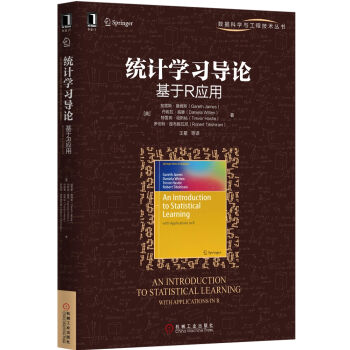
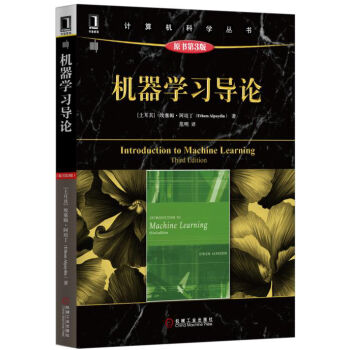


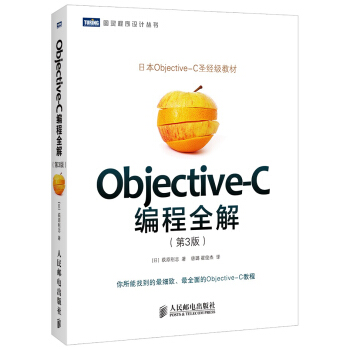
![Autodesk Revit Architecture 2015官方标准教程 [Autodesk Revit Architecture 2015] pdf epub mobi 电子书 下载](https://pic.windowsfront.com/11652604/54dc7cafNdafca4f8.jpg)

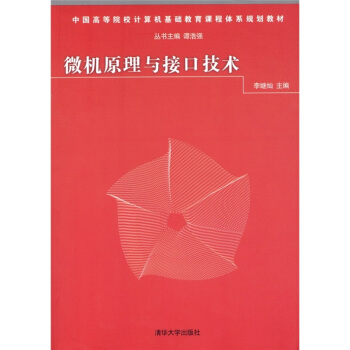
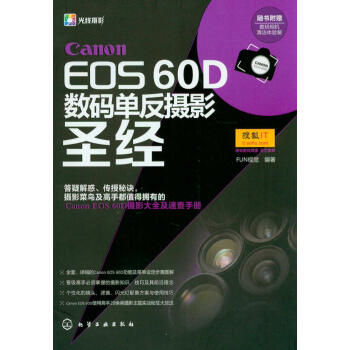



![经典原版书库:计算机网络(英文版·第5版) [Computer Networks, Fifth Edition] pdf epub mobi 电子书 下载](https://pic.windowsfront.com/10854761/8d81a8b8-308f-4ac3-83ed-f40ba01706f8.jpg)
